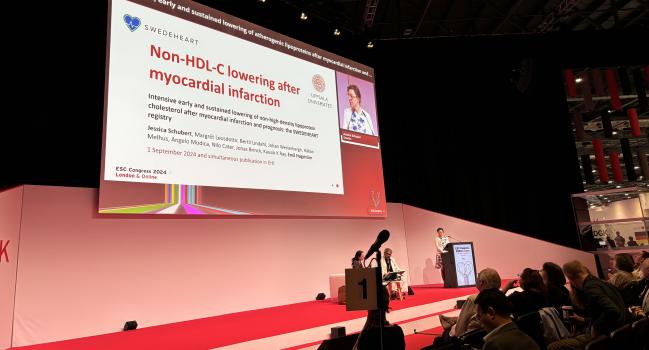Getting to Cholesterol Goal Early After MI Lowers Risk of Recurrent Events
Quickly cutting non-HDL cholesterol after MI lowers the risk of MACE compared with stepwise use of lipid-lowering therapy.

LONDON, England—Aggressive cholesterol lowering at the time of hospitalization for MI results in better clinical outcomes at 1 year when compared with the current stepwise treatment strategy, according to a new analysis from SWEDEHEART presented here at the European Society of Cardiology (ESC) Congress 2024.
Among 56,262 patients (median age 64 years; 26% women) who had a myocardial infarction, those who achieved early and sustained reductions in non-HDL cholesterol—down to less than 2.2 mmol/L by 2 months, which corresponds to an LDL level of less than 1.4 mmol/L, or 55 mg/mL—had the lowest risk of major adverse cardiovascular events.
“It's not news that the lower the better, but this study shows there is a timing aspect,” lead investigator Jessica Schubert, MD (Uppsala University, Sweden), told TCTMD. “If we look at events from the first follow-up at 2 months to the second follow-up at 1 year, the patients who achieved the largest reduction in non-HDL cholesterol, or those who achieved the lowest levels, they had significantly fewer cases of MACE or new myocardial infarction.”
The study shows that “there are lives to be saved in this first year,” said Schubert. Waiting until the outpatient follow-up visit before adding statins, along with ezetimibe and PCSK9 inhibitors as needed, to reduce cholesterol levels “may actually be doing harm instead of giving them early,” she added.
Maciej Banach, MD, PhD (Medical University of Lodz, Poland), who wasn’t involved in this study, but is part of the International Lipid Expert Panel, said the new analysis is important and consistent with prior studies showing that lowering LDL cholesterol (or non-HDL cholesterol) early is better, especially in those at high or very high risk of cardiovascular disease.
“This approach was introduced by the International Lipid Expert Panel in April 2021, when the experts suggested that there is no common sense to wait for the LDL-cholesterol reduction result after high-intensity statin therapy, but for patients after ACS, those at extremely high CVD risk, and those with familial hypercholesterolemia, we should start with up-front lipid-lowering combination therapy of high-intensity statin and ezetimibe," he noted.
Go Low Early
The analysis, was also published simultaneously in the European Heart Journal, challenges the stepwise treatment approach recommended by clinical guidelines, said Schubert. In the 2023 ESC guidelines for the management of acute coronary syndromes, treatment recommendations follow the stepwise escalation approach, with high-potency statins as the first line of attack then followed by ezetimibe and then PCSK9 inhibitors, such as alirocumab (Praluent; Regeneron/Sanofi) and evolocumab (Repatha; Amgen).
While ACS patients currently treated with a high-potency statin might be prescribed ezetimibe during the index admission, or prescribed a PCSK9 inhibitor if they are taking a statin and ezetimibe already, the guidelines recommend follow-up visits at 4 to 6 weeks to escalate therapy in patients who were not treated with a statin prior to the ACS. In these patients, additional agents are recommended if LDL-cholesterol levels remain higher than 1.4 mmol/L (55 mg/dL).
It's not news that the lower the better, but this study shows there is a timing aspect. Jessica Schubert
With the SWEDEHEART analysis, researchers wanted to study the timing and magnitude of lowering non-HDL cholesterol, a reflection of total atherogenic lipids, and subsequent recurrent risks after MI. Among the more than 56,200 patients with MI, there were 9,549 recurrent MACE events (all-cause mortality, MI, or ischemic stroke), 5,427 deaths, and 3,946 MIs during a median 5.4 years of follow-up.
Of the 20,539 patients with the largest percent change in non-HDL cholesterol (≥ 46%), 53% were prescribed a high-intensity statin monotherapy and 30% were prescribed a high-intensity statin and ezetimibe. For the group of patients with no reduction in non-HDL cholesterol, just 6% were treated with a high-intensity statin and ezetimibe.
Not surprisingly, the cumulative incidence of MACE in long-term follow-up was significantly lower in patients who achieved the largest reduction in non-HDL cholesterol at 1 year (≥ 2.2 mmol/L) compared with those with smaller reductions.
When investigators looked at the timing of achieved non-HDL targets and outcomes, those who lowered non-HDL-cholesterol levels to 1.9 mmol/L or less at 2 months had a lower risks of MACE and MI within 1 year when compared with those with an achieved level of 2.9 mmol/L or greater (HR 0.80; 95% CI 0.68-0.92 and HR 0.74; 95% CI 0.61-0.90, respectively). Similarly, those with the largest change in non-HDL cholesterol from admission to 2 months—more than a 2.2-mmol/L reduction—had a 28% lower risk of MACE and 28% lower risk of MI within 1 year.
Lower levels of non-HDL cholesterol at 1 year, as well as larger changes in non-HDL cholesterol in the year after MI, were associated with lower risks of MACE in long-term follow-up.
The early and sustained achievement of non-HDL-cholesterol levels—down to a target of 2.2 mmol/L or less at 2 months and sustained to 1 year—was associated a 20% lower risk of MACE in follow-up when compared with patients who failed to hit the cholesterol target. Those who eventually got to goal at 1 year—but who weren’t at goal by 2 months—had a 14% lower risk of MACE compared with the group who failed to get to goal at all.
More Likely to Get to Target
With the current treatment approaches, Schubert said more and more physicians in Sweden are prescribing high-potency statins during the hospital admission, but that the prescription of ezetimibe is less frequent. Adopting an approach that would aggressively target atherogenic cholesterol levels during the index admission could help with clinical inertia that exists during follow-up, she added.
“If we add these high-intensity combination therapies from day one at discharge, it’s much more likely that they’ll reach the target,” said Schubert.
To TCTMD, Banach pointed out that the use of statin therapy plus ezetimibe early was confirmed in the RACING trial. In that study, up-front combination therapy in patients with atherosclerotic cardiovascular disease saw more patients reach the LDL-cholesterol target of less than 70 mg/dL. Several other studies found that up-front combination lipid-lowering therapy was associated with significantly better clinical outcomes.
“In the cohort of patients after ACS from the Polish ACS Registry, we showed that up-front combination lipid-lowering therapy versus high-intensity statin monotherapy was associated with a significant reduction of all-cause mortality after 3 years with a number-needed-to-treat of 21, and with the significant differences observed already after 52 days,” said Banach.
At the ESC Congress, Banach also presented a meta-analysis of 11 studies with more than 106,000 patients showing that the up-front use of combination therapy and was more effective at reducing LDL cholesterol from baseline and resulted in lower risks of all-cause mortality, cardiovascular mortality, and MACE. Additionally, the rates of adverse events and therapy discontinuation were similar compared with statin monotherapy.
There’s also a practical element to the more aggressive combination approach, said Schubert.
“There are many other aspects of care that need to be covered when the patient comes to the follow-up visits or afterwards when they are followed in primary care,” she said. The stepwise strategy involves multiple visits and increasing the number of steps between treatments runs the risk of forgetting to intensity therapy, she added.
In terms of risks, Schubert said there aren’t significant interactions with the lipid-lowering therapies and other medications, such as antiplatelet therapy, diabetes medications, or antihypertensives, though there is a psychological challenge for patients started on multiple lifetime drugs after ACS. Also, if there are side effects, such as muscle pain or weakness, it might be challenging to identify the therapy responsible, although physicians will usually start by lowering the dose of statin. The stepwise approach wouldn’t necessarily have this problem of identifying the culprit.
“That might be preferable from a pharmacological point of view should they have a reaction or side effect to one of the drugs,” said Schubert. “But the clinical reality is such that we have limited of time with the patients and limited capacity for following up. The reality of that approach is that it might lead to patients being undertreated where we forget to intensify therapy, for whatever reason. We think the next doctor can take care of that, or we'll look at it on the next follow up, but then it's never done.”
Michael O’Riordan is the Managing Editor for TCTMD. He completed his undergraduate degrees at Queen’s University in Kingston, ON, and…
Read Full BioSources
Schubert J, Leosdottir M, Lindahl B, et al. Non-HDL cholesterol lowering after myocardial infarction. Presented at: ESC 2024. September 1, 2024. London, England.





Comments